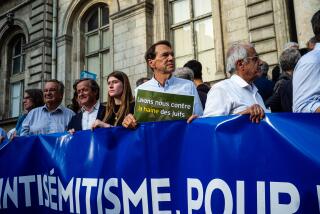After 2 Millenia, a Pope Will Visit a Synagogue
- Share via
ROME — Rome’s Jewish ghetto, the second in Europe, came into being in 1555 by papal edict. Thirty-nine years earlier, the Venetians, even though their economy remained mutually dependent on the local Jewish community, consigned the Jews to an abandoned area where four foundries ( ghetto means foundry in Venetian dialect) once stood. They claimed it offered the Jews protection from occasional raids by zealous bigots from the mainland.
The gates to Venice’s ghetto were unhinged forever in 1797; those of Rome remained theoretically operative until Italian troops captured Rome in 1870, making it part of modern Italy. Until then, Rome’s Jewish community, the oldest in Europe, had to count on the wisdom or whims of a string of Roman emperors and popes for their continuous existence.
Until the middle of the last century, Rome’s Jewish males had to run a footrace down the main street of the papal city and present the Pope’s governor-general with a bag of gold. Then the city’s chief rabbi turned his back to receive from the Pope’s man a ritual kick in the rump. Like public executions, this was all part of a spectacle meant also to be educational.
Next Sunday4/, Pope John Paul II is to visit Rome’s main synagogue in the ghetto to join Rabbi Elio Toaff in the Old Testament prayers both religions share. This, too, could be called a public ritual meant also to be educational, but it is more than that.
For one thing, it marks the 20th anniversary of the Vatican Council’s document on the Jews, considered theologically revolutionary at the time and now too often forgotten by all Christians. That declaration, inspired by a German Jesuit, the late Cardinal Augustin Bea, aimed to put an end to the term “Christ-killers,” used mostly by the young or the ignorant, to taunt the Jews. The Vatican document said that in no way could the Jews of Christ’s time, as a people--and there were then between 5 million and 6 million of them living outside of Palestine--be blamed for the decision of a few Jewish elders in Jerusalem. That is a lesson that seems to require drumming-in to each generation. The Pope’s visit to the synagogue is likely to remind everyone who will listen of that simple fact.
When the visit to the ghetto was announced last month, it was said then that Pope John Paul will be the first Pope to set foot in a synagogue. Since Roman Catholic tradition always lists St. Peter as the first Pope, and the first to be martyred in Rome, he would also have also been the first “Pope” to enter a synagogue after his conversion. His mission in Rome was, in fact, to convert the city’s 30,000 Jews to what was then considered a new Jewish cult. Like all non-Romans, Peter was obliged to live in a foreigners’ quarter, probably in what is today called Rome’s Trastevere (meaning across the Tiber) district.
There are no statistics on Peter’s successful conversions of his fellow Jews. It may have been an uphill battle for their souls, because many of Rome’s Jews were members of the royal court; others had prospered as merchants. From Caesar’s time, they had been exempted from paying a tithe for the support of Jupiter, Juno and others, provided they supported their local synagogues. There were then 15 in Rome, referred to by the Romans as “colleges” or “schools,” and they were probably not marble temples but simple centers for prayers. Since the Jews did not believe in the Roman tradition of cremation, they buried their dead in the catacombs, those natural caves upon which most of Rome was built. Five of those cemeteries have been found in the last century--one of them under Benito Mussolini’s official residence.
There is a mosaic in a Rome church that shows the emperor Constantine listening to a theological debate between Rome’s rabbi and St. Sylvester, who was Pope in the Third Century. It was Constantine who ruled that Christianity could co-exist with his own pagan religion and one wonders if he was ever dithering between giving Judaism the same official recognition--but at that time it was probably not thought necessary.
In the ruins of a page-boys’ school on the Palatine hill, there is a crude graffito of a donkey being crucified, meant to taunt a fellow student named Alexander, whose parents (probably Greek, from that name) had apparently become Christians. Children can be cruel to those who dare to be different.
In Rome’s Dark Ages, nothing much is known about the Jews or about anyone else, but the Jewish community survived. In the Renaissance, they were men of science, astrologers-astronomers (the same thing then), and one Jew was physician to two popes. It was a natural thing for Michelangelo to carve his statue of Moses for the tomb of his patron-Pope, and the entire ceiling of the Sistine Chapel was dedicated by him to Old Testament figures.
In 1943, during the German occupation, 2,091 Jews were deported, some of them to Polish concentration camps, and only 15 returned. One of those, Alberto Mieli, now 60, still works in the ghetto and still bears the number 180060 on his arm. About 2,000 Jews now live in the ghetto, and about 5,000 have their work there. Mieli said, “I’m sure that April 13 will shut for all times a sad chapter, that of the incomprehensions and humiliations. A new one will open that finally will acknowledge that we’re all children of God.”
Rome is a city today of 3 million people, but fewer than 500,000 of them are third or fourth generation. Because the probability of intermarriage is greater, Rome’s Jews could be the most Roman of them all. Next Sunday, the successor of Peter the Fisherman may be meeting some Romans whose ancestors knew Peter. And perhaps chased him from the synagogue as a troublesome subversive.
More to Read
Sign up for Essential California
The most important California stories and recommendations in your inbox every morning.
You may occasionally receive promotional content from the Los Angeles Times.













